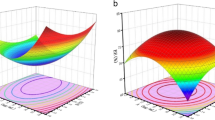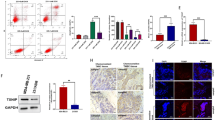Abstract
Metastasis is one of the main reasons causing death in cancer patients. It was reported that chemotherapy might induce metastasis. In order to uncover the mechanism of chemotherapy-induced metastasis and find solutions to inhibit treatment-induced metastasis, the relationship between epithelial-mesenchymal transition (EMT) and doxorubicin (DOX) treatment was investigated and a redox-sensitive small interfering RNA (siRNA) delivery system was designed. DOX-related reactive oxygen species (ROS) were found to be responsible for the invasiveness of tumor cells in vitro, causing enhanced EMT and cytoskeleton reconstruction regulated by Ras-related C3 botulinum toxin substrate 1 (RAC1). In order to decrease RAC1, a redox-sensitive glycolipid drug delivery system (chitosan-ss-stearylamine conjugate (CSO-ss-SA)) was designed to carry siRNA, forming a gene delivery system (CSO-ss-SA/siRNA) down-regulating RAC1. CSO-ss-SA/siRNA exhibited an enhanced redox sensitivity compared to nonresponsive complexes in 10 mmol/L glutathione (GSH) and showed a significant safety. CSO-ss-SA/siRNA could effectively transmit siRNA into tumor cells, reducing the expression of RAC1 protein by 38.2% and decreasing the number of tumor-induced invasion cells by 42.5%. When combined with DOX, CSO-ss-SA/siRNA remarkably inhibited the chemotherapy-induced EMT in vivo and enhanced therapeutic efficiency. The present study indicates that RAC1 protein is a key regulator of chemotherapy-induced EMT and CSO-ss-SA/siRNA silencing RAC1 could efficiently decrease the tumor metastasis risk after chemotherapy.
摘要
目 的
探明 RAC1 蛋白调控阿霉素 )DOX) 诱导肿瘤转移机制, 设计靶向 RAC1 的小干扰 RNA )siRNA) 递释系统, 抑制 DOX 治疗诱导的肿瘤皮质间质样 )EMT) 转化.
创新点
探明了 DOX 通过 RAC1 蛋白诱导肿瘤细胞发生转移性变化的机制, 构建了靶向沉默 RAC1 蛋白 的 siRNA 递释系统, 有效降低了 DOX 化疗后肿瘤组织转移的风险. 方法: 选用 MCF-7 细胞为模型细胞, 体外考察 DOX 相关活性氧 )ROS) 对 RAC1 蛋白的调控作用. 针对肿瘤细胞内高谷胱甘肽 )GSH) 浓度的氧化还原条件, 选用二硫键为敏感桥链, 壳聚糖为亲水性骨架, 硬脂胺为疏水基团,构建氧化还原敏感型基因药物载体 CSO-ss-SA. 选择靶向沉默 RAC1 的 siRNA 为模型药物, 构建基因药物递释系统 CSO-ss-SA/siRNA. 考察 CSO-ss-SA/siRNA 的理化性质, 体外敏感释放及细胞摄取. 通过免疫荧光染色法, 蛋白免疫印迹法和细胞侵袭性实验考察基因药物递释系统的细胞药效. 选用 Balb/c 裸鼠构建 MCF-7 乳腺肿瘤原位荷瘤动物模型, 考察CSO-ss-SA/siRNA 对DOX 治疗诱导肿瘤组织 EMT 转化的抑制作用
结论
RAC1 是 DOX 诱导细胞侵袭性的关键蛋白. 靶向沉默 RAC1 的siRNA 基因递释系统可在体内外有效抑制 DOX 治疗诱导的肿瘤组织EMT 转化, 降低化疗诱导转移的风险.
Similar content being viewed by others
Change history
28 February 2022
An Erratum to this paper has been published: https://doi.org/10.1631/jzus.B19e0468
References
Cadenas S, 2018. ROS and redox signaling in myocardial ischemia-reperfusion injury and cardioprotection. Free Radic Biol Med, 117:76–89. https://doi.org/10.1016/j.freeradbiomed.2018.01.024
Chan TS, Hsu CC, Pai VC, et al., 2016. Metronomic chemotherapy prevents therapy-induced stromal activation and induction of tumor-initiating cells. J Exp Med, 213(13):2967–2988. https://doi.org/10.1084/jem.20151665
De P, Aske JC, Dey N, 2019. RAC1 takes the lead in solid tumors. Cells, 8(5):382. https://doi.org/10.3390/cells8050382
Ebos JML, 2015. Prodding the beast: assessing the impact of treatment-induced metastasis. Cancer Res, 75(17):3427–3435. https://doi.org/10.1158/0008-5472.can-15-0308
Fu XD, 2017. Both sides of the same coin: Rac1 splicing regulation by EGF signaling. Cell Res, 27(4):455–456. https://doi.org/10.1038/cr.2017.19
Grobe H, Wüstenhagen A, Baarlink C, et al., 2018. A Rac1-FMNL2 signaling module affects cell-cell contact formation independent of Cdc42 and membrane protrusions. PLoS ONE, 13(3):e0194716. https://doi.org/10.1371/journal.pone.0194716
Hao LG, Rong W, Bai LJ, et al., 2019. Upregulated circular RNA circ_0007534 indicates an unfavorable prognosis in pancreatic ductal adenocarcinoma and regulates cell proliferation, apoptosis, and invasion by sponging miR-625 and miR-892b. J Cell Biochem, 120(3):3780–3789. https://doi.org/10.1002/jcb.27658
Hu YW, Du YZ, Liu N, et al., 2015. Selective redoxresponsive drug release in tumor cells mediated by chitosan based glycolipid-like nanocarrier. J Control Release, 206:91–100. https://doi.org/10.1016/j.jconrel.2015.03.018
Huang D, Cao L, Xiao L, et al., 2019. Hypoxia induces actin cytoskeleton remodeling by regulating the binding of CAPZA1 to F-actin via PIP2 to drive EMT in hepatocellular carcinoma. Cancer Lett, 448:117–127. https://doi.org/10.1016/j.canlet.2019.01.042
Hung CM, Hsu YC, Chen TY, et al., 2017. Cyclophosphamide promotes breast cancer cell migration through CXCR4 and matrix metalloproteinases. Cell Biol Int, 41(3):345–352. https://doi.org/10.1002/cbin.10726
Karagiannis GS, Condeelis JS, Oktay MH, 2018. Chemotherapy-induced metastasis: mechanisms and translational opportunities. Clin Exp Metastasis, 35(4):269–284. https://doi.org/10.1007/s10585-017-9870-x
Keklikoglou I, Cianciaruso C, Güç E, et al., 2019. Chemotherapy elicits pro-metastatic extracellular vesicles in breast cancer models. Nat Cell Biol, 21(2):190–202. https://doi.org/10.1038/s41556-018-0256-3
Korol A, Taiyab A, West-Mays JA, 2016. RhoA/ROCK signaling regulates TGFβ-induced epithelial-mesenchymal transition of lens epithelial cells through MRTF-A. Mol Med, 22(1):713–723. https://doi.org/10.2119/molmed.2016.00041
Liu J, Meng T, Yuan M, et al., 2016. MicroRNA-200c delivered by solid lipid nanoparticles enhances the effect of paclitaxel on breast cancer stem cell. Int J Nanomed, 11:6713–6725. https://doi.org/10.2147/ijn.s111647
Liu X, Cheng BL, Meng TT, et al., 2016. Synthesis and biological application of BKT-140 peptide modified polymer micelles for treating tumor metastasis with an enhanced cell internalization. Polym Chem, 7(7):1375–1386. https://doi.org/10.1039/C5PY01807B
Liu XX, Liu WD, Wang L, et al., 2018. Roles of flotillins in tumors. J Zhejiang Univ-Sci B (Biomed & Biotechnol), 19(3):171–182. https://doi.org/10.1631/jzus.B1700102
Liu ZL, Shen N, Tang ZH, et al., 2019. An eximious and affordable GSH stimulus-responsive poly(α-lipoic acid) nanocarrier bonding combretastatin A4 for tumor therapy. Biomater Sci, 7(7):2803–2811. https://doi.org/10.1039/C9BM00002J
Meng TT, Wu J, Yi HX, et al., 2016. A spermine conjugated stearic acid-g-chitosan oligosaccharide polymer with different types of amino groups for efficient p53 gene therapy. Coll Surf B-Biointerf, 145:695–705. https://doi.org/10.1016/j.colsurfb.2016.05.071
Mirzaei S, Hadadi Z, Attar F, et al., 2018. ROS-mediated heme degradation and cytotoxicity induced by iron nanoparticles: hemoglobin and lymphocyte cells as targets. J Biomol Struct Dyn, 36(16):4235–4245. https://doi.org/10.1080/07391102.2017.1411832
Polyakov N, Leshina T, Fedenok L, et al., 2018. Redox-active quinone chelators: properties, mechanisms of action, cell delivery, and cell toxicity. Antiox Redox Signal, 28(15):1394–1403. https://doi.org/10.1089/ars.2017.7406
Quail DF, Joyce JA, 2013. Microenvironmental regulation of tumor progression and metastasis. Nat Med, 19(11):1423–1437. https://doi.org/10.1038/nm.3394
Sun T, Wang GF, Zhang Y, 2017. Primary splenic carcinosarcoma with local invasion of chest wall: a rare case. J Zhejiang Univ-Sci B (Biomed &Biotechnol), 18(8):717–722. https://doi.org/10.1631/jzus.B1700262
Tan YN, Zhu Y, Zhao Y, et al., 2018. Mitochondrial alkaline pH-responsive drug release mediated by celastrol loaded glycolipid-like micelles for cancer therapy. Biomaterials, 154:169–181. https://doi.org/10.1016/j.biomaterials.2017.07.036
Vaquero J, Fouassier L, 2016. Rac1 and EMT: a dangerous liaison? Transl Cancer Res, 5(Suppl 7):S1483–S1485. https://doi.org/10.21037/tcr.2016.12.42
Weidenfeld K, Barkan D, 2018. EMT and stemness in tumor dormancy and outgrowth: are they intertwined processes? Front Oncol, 8:381. https://doi.org/10.3389/fonc.2018.00381
Wen LJ, Tan YN, Dai SH, et al., 2017. VEGF-mediated tight junctions pathological fenestration enhances doxorubicinloaded glycolipid-like nanoparticles traversing BBB for glioblastoma-targeting therapy. Drug Deliv, 24(1):1843–1855. https://doi.org/10.1080/10717544.2017.1386731
Yan JJ, Du YZ, Chen FY, et al., 2013. Effect of proteins with different isoelectric points on the gene transfection efficiency mediated by stearic acid grafted chitosan oligosaccharide micelles. Mol Pharm, 10(7):2568–2577. https://doi.org/10.1021/mp300732d
Zhao M, Ding XF, Shen JY, et al., 2017. Use of liposomal doxorubicin for adjuvant chemotherapy of breast cancer in clinical practice. J Zhejiang Univ-Sci B (Biomed & Biotechnol), 18(1):15–26. https://doi.org/10.1631/jzus.B1600303
Zhu Y, Yan L, Zhu WJ, et al., 2019. MMP2/3 promote the growth and migration of laryngeal squamous cell carcinoma via PI3K/AKT-NF-κB-mediated epithelial-mesenchymal transformation. J Cell Physiol, 234(9):15847–15855. https://doi.org/10.1002/jcp.28242
Author information
Authors and Affiliations
Contributions
Xuan LIU performed the experimental research and data analysis, wrote and edited the manuscript. Xue-qing ZHOU performed the data analysis and participated in the paperwork. Xu-wei SHANG contributed in polymer synthesis. Li WANG contributed in image analysis. Yi LI collected and analyzed the data. Hong YUAN and Fu-qiang HU contributed in the study design. All authors have read and approved the final manuscript, have full access to all the data in the study, and take responsibility for the integrity and security of the data.
Corresponding author
Additional information
Compliance with ethics guidelines
Xuan LIU, Xue-qing ZHOU, Xu-wei SHANG, Li WANG, Yi LI, Hong YUAN, and Fu-qiang HU declare that they have no conflict of interest.
All institutional and national guidelines for the care and use of laboratory animals were followed.
Project supported by the National Natural Science Foundation of China (No. 81773648), the Zhejiang Provincial Natural Science Foundation of China (No. D19H30001), and the Chinese Postdoc Funding (No. 2018M630686)
Rights and permissions
About this article
Cite this article
Liu, X., Zhou, Xq., Shang, Xw. et al. Inhibition of chemotherapy-related breast tumor EMT by application of redox-sensitive siRNA delivery system CSO-ss-SA/siRNA along with doxorubicin treatment. J. Zhejiang Univ. Sci. B 21, 218–233 (2020). https://doi.org/10.1631/jzus.B1900468
Received:
Accepted:
Published:
Issue Date:
DOI: https://doi.org/10.1631/jzus.B1900468
Key words
- Doxorubicin
- Tumor metastasis
- Ras-related C3 botulinum toxin substrate 1 (RAC1)
- Epithelial-mesenchymal transition (EMT)
- Chitosan micelles
- Small interfering RNA (siRNA)




